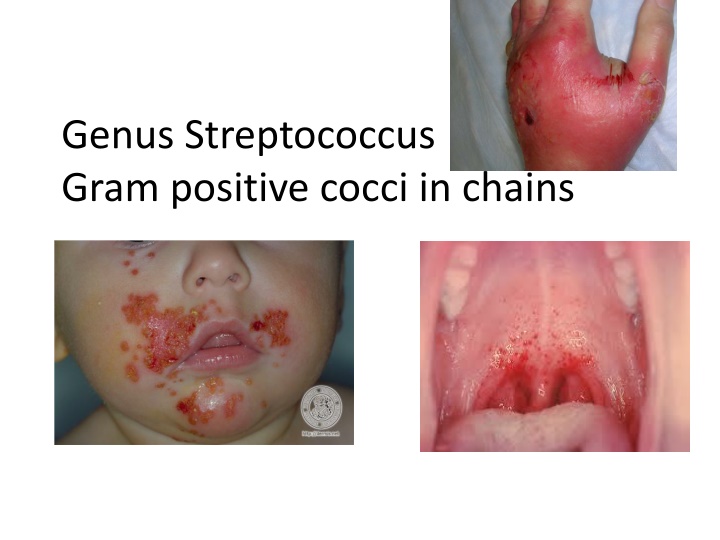
Streptococcus Bacteria Classification and Characteristics
Learn about Streptococcus bacteria, including their classification, hemolysis types, and cultural characteristics. Explore images and descriptions to understand their morphology, biochemical reactions, and antigenic structure.
Uploaded on | 1 Views
Download Presentation

Please find below an Image/Link to download the presentation.
The content on the website is provided AS IS for your information and personal use only. It may not be sold, licensed, or shared on other websites without obtaining consent from the author. If you encounter any issues during the download, it is possible that the publisher has removed the file from their server.
You are allowed to download the files provided on this website for personal or commercial use, subject to the condition that they are used lawfully. All files are the property of their respective owners.
The content on the website is provided AS IS for your information and personal use only. It may not be sold, licensed, or shared on other websites without obtaining consent from the author.
E N D
Presentation Transcript
Genus Streptococcus Gram positive cocci in chains
Streptococci (Classification) O2requirement Aerobic & facultative Obligate anaerobes anaerobes eg.Peptostreptococcus Hemolysis Alpha hemolytic Beta-haemolytic (Viridans group) Classified Serological grouping into species (Carbohydrate C) based on physiological 20 Lancefield groups & biochemical (A to V except I &J) properties Serological typing(M Protein) Griffith types (1,2,3 etc. upto 80 types) Gamma hemolytic (Enterococcus group) Classified into species based on physiological & biochemical properties
Alpha haemolytic: greenish discoloration around colonies detected on BA due to partial hemolysis. Eg. Viridans streptococci and Streptococcus pneumoniae. Beta haemolysis: clear colorless zone of complete haemolysis. Eg: Streptococcus pyogenes. Gamma hemolysis: non hemolytic
Streptococcus pyogenes (Group A streptococci) Morphology: Gram positive cocci(GPC) 0.5-1.0 m in diameter arranged in chains due to the cocci dividing in one plane only & daughter cells failing to separate complete. Some strains have protein capsule of hyaluronic acid.
Cultural characteristics: Aerobes & facultative anaerobes. Grows only on media containing blood, serum or glucose in 24 hours. On BA: colonies are small, pin-point, semi- transparent, low convex with wide zone of - haemolysis. Selective medium -1:500,000 crystal violet BA Liquid media glucose broth. Growth occurs as granular turbidity with powdery deposit. Bacterial chains being heavier settle down as deposit.
Biochemical Reactions: CATALASE negative, all staphylococcus are catalase positive. Bacitracin sensitive.
Antigenic Structure: 1. Capsular Hyaluronic Acid- capsule inhibits phagocytosis 2. Group Specific Polysaccharide Antigen- 20 Lancefield groups (A toV except I&J) 3. Type Specific Antigen- Protein antigens(80 Griffith serotypes) further subdivided based on surface proteins into M,T &R.
Toxins and Enzymes contribute to virulence Toxins: Exotoxins. i. Haemolysins: 2 types of haemolysins produced. Streptolysin O - Oxygen labile & heat labile, lyses RBC & cytotoxic for neutrophils &cardiac tissue. It is antigenic antistreptolysin O (ASO)appears in serum following streptococcal infection, titre >200 units. Streptolysin S - Oxygen stable responsible for haemolysis around colonies on BA plate. Not antigenic. ii. Pyrogenic toxin(Erythrogenic toxin) - Responsible for rash in Scarlet fever.
Enzymes: i. Streptokinase(fibrinolysin): Promotes lysis of fibrin. Facilitates spread of infection by breaking down fibrin barrier. ii. Deoxyribonuclease (Streptodornase): liquify the highly viscous DNA and responsible for thin serous character of streptococcal pus. iii. Nicotinamide adenine dinucleotidase (NADase): leucotoxic. iv. Hyaluronidase: breaksdown hyaluronic acid & helps spread of infection in intracellular spaces
Pathogenesis Area of involvement Organism Lesion Str. Pyogenes: i. Pyogenic infections(Supp- urative infec- tions) Respiratory tract Skin infections Wounds, burns and skin lesions, eczema, eryseplas, impetigo Acute tonsillitis or pharyngitis, scarlet fever Genital infections Puerperal sepsis Deep infections Bone and joint infections, septicaemia, lymphadenitis, ii. Non suppurative complications Rheumatic fever and Acute Glomerulonephritis
Non-Suppurative Complications 1. Acute Rheumatic fever(ARF) A disease involving the heart valves more commonly Mitral and Tricuspid valves. 2. Acute Glomerulonephritis(AGN)- disease of the glomerulus of kidney These complications occur 1-4 weeks after the acute infection. Str. pyogenes is no longer detectable when these complications set in. ARF is preceded by sore throat and AGN usually by skin infection, sometimes also by throat infection. Reason: probably common cross reacting antigen.
Group A streptococcal infection of throat -----> antibodies produced ----> Abs cross react with myocardium and heart valves ------> complement component C3 &C5 activation and tissue destruction. Streptococcal skin infection -----> Ab s produced that cross react with components of glomerular basement membrane -----> comlement activation and tissue destruction.
Lab diagnosis 1. For pyogenic (Acute suppurative)infections: Streptococcus pyogenes can be isolated. a. Specimen: pus, blood, CSF. b. Collection & transport: collect aseptically and inoculate immediately OR transport in Pike s transport medium. c. Gram s staining: GPC in chains d. Culture: specimen is inoculated on blood agar medium and incubated at 37oC for 18-24 hours.
e. Colony morphology and Staining: - On BA Pin-point semitransparent colonies with wide zone of -haemolysis. - Gram stain from colonies: GPC in chains. - Liquid medium(glucose broth): Granular turbidity with powdery deposit. f. Biochemical Reactions: catalase negative g. Identification: 1) Bacitracin sensitivity: more sensitive than other bacteria to bacitracin 1unit/ml 2) CAMP test negative test positive for group B. h. Lancefield grouping.
2. For Non suppurative complications- Str. Pyogenes cannot be isolated Antibody detection (Serology)provide retrospective evidence of streptococcal infection Antistreptolysin O (ASO) test: a titre of >200 units is significant in ARF and indicates prior streptococcal infection. ASO test is a toxin neutralisation test For AGN antideoxyribonuclease B (anti-DNAase is more reliable. Titres > 300to350 is significant.
Treatment Penicillin G is the drug of choice. In patients allergic to penicillin erythromycin or cephalexin is used. Vaccines are not available.
